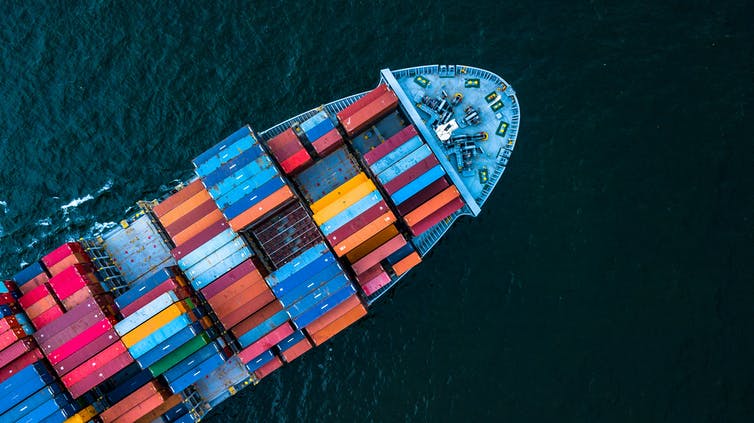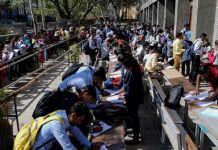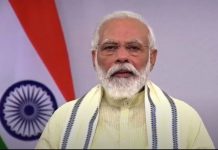India is a developing economy with high reliability on the tertiary/service sector. When the present head of the state came to power in the year 2014 he promised us to provide a better standard of living along with a prosperous business milieu. Naturally, a rational step towards this goal had to go through sound policymaking. And hence some of the steps taken by the present regime towards this goal included the conversion of Planning Commission into NITI Aayog, bringing down of the slabs for Foreign Direct Investment (FDI) and Foreign Institutional Investment (FII), privatization of those sectors of our economy that failed to perform well, and so on… All these steps were directed towards Make in India, a type of Swadeshi Movement, which was launched on the 25th of September, 2014, in order to strengthen our manufacturing/secondary sector. Ironically, none of these steps bore fruits for us eventually. Rather, what we witnessed, later on, was an intense downward spiral of our economy – as indicated by our Gross Domestic Product (GDP) year after year.
In this article, we will evaluate the implications of certain political decisions on our economy, and retrospect on the dream of Make in India provided to us by our prime minister a long time ago.
Demonetisation: An architect of financial slowdown
The first major historical step, to boost our economy, taken by our prime minister was Demonetisation. His argument behind this decision was to get hold of the black money circulating in our economy. Some argue that the decision, which was taken on the 8th of November 2016, was, in fact, a political trick to restrict Mayawati and Akhilesh from winning the elections of Uttar Pradesh. On the other hand, there were opinions in the public domain that tried to justify it by the economic growth portrayed by our GDP at the beginning of 2017. However, three noteworthy blunders made by this quixotic decision were:
- Ignorance of Renard Series: French Engineer Charles Renard once opined that the ratio of 1:2:5 can achieve any digit/number through a permutation or combination. For instance, if a vegetable seller in an Indian village forgets to carry the weighing bar of say 1 kilogram (1000 grams) to his shop on a particular day; he can substitute that weighing bar with either 5 bars of 200gm, or 2 bars of 500gm, or say 1 bar of 100gm followed by 2 bars of 200gm and 1 bar of 500gm. Such combinations can be made in many ways in order to achieve a particular whole number. Precisely the same logic is used to decide the denominations of currencies in most of the economies of our globe – India is one such case as well. Take a look at our denominations when demonetisation took place. They are in the following order: ₹1, ₹2, ₹5, and then, ₹10, ₹20, ₹50, and then, ₹100, ₹500, and then ₹1000. The Indian currency ranging from ₹1 to ₹100 followed the Renard series but didn’t move ahead of it. This burdened the smaller denominations to fill the gap between ₹100 & ₹500, and in between ₹500 to ₹2000 which were newly introduced in the market after demonetization. The obligation of the Reserve Bank of India to supply new notes of ₹500 and ₹2000 on one hand, and with smaller denominations, on another hand, ultimately culminated into cash crush.
- Unreflected liquidity: Even though illegal but the black money circulating in our economy endorses demand and facilitates liquidity in the market. The irony was that this liquidity, which was generated and maintained by the black economy, was overlooked, or maybe, was considered to be ‘excessive’ prior to the decision of demonetization. Indeed, it is true that it is difficult to control and channelize the flow of black money because the state remains unaware of its whereabouts. Yet the decision of demonetization in haste created havoc that yielded no substantial outcome. The surplus of liquidity produced by the ‘black’ money was misread and as a result, was dealt with severity. The black money, when spent, in the market also circulates among the adherents of the unorganized sector. As a corollary, they were the most affected strata of our society when demonetization took place.
- Betrayal of promise: Every note comes with a promise that says “I promise to pay the bearer the sum of” a certain amount of “rupees”. When demonetization took place these words became meaningless. And all the notes of denomination 500 and 1000 got reduced to invaluable papers.
The spectre of demonetisation haunts the consciousness of our economy even today. Just a couple of months after this phenomenon many start-ups failed to survive, many small enterprises succumbed, and the uncertainty looming in the minds of the investors brought down their confidence from our economy.
Denial of the undeniable
When the current prime minister of our country came to power for the first time we presumed that we will get rid of massive unemployment, hunger, squalor, illiteracy, malnutrition, poverty and farmers distress. However, only hollow speeches, meaningless promises, fabricated dreams, and manufactured hope are some of the products that we have received so far from the manager of our nation – whom we’ve chosen for our management. The present regime, ironically, can afford to construct statues one after the other, but it cannot fund the education of its own students. It can fund the Jio Institute of Imminence for its development but cannot spend on the institutional development of the healthcare facilities of our nation. Also, the exchequer of our government has adequate funds for the fulfilment of the whimsical foreign tours of our beloved prime minister, yet it cannot subsidise the price of fuels and other eatables when they go through galloping inflation. Indeed, it is true that generally employment brings inflation along with it. The principle of the Phillips Curve still holds the merit of this condition even today. Nevertheless, what is contradictory at this moment is that on one hand the price of eatables such as pulses, onions, milk, tomatoes, garlic, ginger and the fares of railways, along with our other basic necessities such as petrol/diesel and education are constantly encountering a hefty increase, but on the other hand, the rate of employment is not growing up proportionally. This situation, undoubtedly, is alarming as this might lead to stagflation in the nearby future if not taken seriously.
Inequality, not only in terms of class but also in terms of gender, has been growing constantly. As per the World Economic Forum (WEF) Global Gender Gap report, India has slipped four places on the Global Gender Gap index to 112, behind neighbours China, Sri Lanka, Nepal and Bangladesh, due to rising disparity in terms of women’s health and participation in the economy. Also, the net worth of the richest man of Asia, Mr Mukesh Ambani, is continuously increasing but the GDP of our economy is proportionally falling. It seems like losses and risks are socialized to the extent possible, while profits are privatized with the passage of time. Despite everything, all forms of critiques are countered today with a mockery or an illogical argument that undermines the entire debate. Almost all the criticisms from the opposition are silenced by calling the leader of the opposition Pappu – a Hindi lexical weapon, which means imbecile. However, the same man is blamed for instigating the masses when people come out of on the streets to show their resentment against the policies of the government… Every winter, trains and flights run at least four to five hours late due to which passengers face lots of difficulties and inconvenience. The technology to resolve this situation needs to be imported at a price which our government is not willing to spend at this moment. However, our government has the capacity to spend on bullet trains, and other such luxury trains of our country. Such decisions naturally indicate certain priorities and preferences. In other words, the allocation of the resources and the mobilization of funds are directed towards the making of an India where there will be much for few but few for the many.
If we recall the humbug of 15lakhs, which was used to lure us six years back, what we realise that instead of providing us with 15lakhs, this regime, rather remained numb and inactive when a huge quantum of our hard-earned labour was misused by Vijay Mallya, Mehul Choksy, and Nirav Modi. This eventually culminated into the rise of NPAs (NonPerforming Assets) in our banks. And we were the ones who were burdened with the responsibility of alleviating the effect of this disaster. RBI, which already encountered the resignation of two prominent governors, is now constantly coming up with new rules that don’t come from any economic theory/principle. For instance, the rule that penalized us with a fine for having less than five thousand bucks in our bank accounts did not make any sense at all. Internet banking charges, ATM withdrawal limitations, and charges, in the metropolitan and non-metropolitan cities kept on changing from time to time, which made the customers of the banks perplexed and busy with these rules and regulations. Recently, American economist Steve Hanke, who teaches at John Hopkins University (USA) and had once served the council of Economic Advisers of former US President Ronald Reagan, predicted that our GDP growth rate in 2020 will be around 5%. He also opined that the ‘world’s largest democracy’ has already transformed into ‘world’s largest police state’. But I wonder what makes our Prime Minister confidently assert everywhere that everything is fine in India.
An Economy beyond redemption
It is an inevitable fact that there is no economics without politics – every economic model is built on political assumptions. Hence, be it market-socialism, or neoliberalism, it has to be cushioned with proper infrastructure so that it can flourish for the benefit of the society. Sadly, when Article 370 got revoked in Kashmir it jeopardized the possibilities of trade & commerce in Kashmir. The tourism industry which is the major source of income of this state cannot use the internet properly till date. Kashmir is also known for exporting shawls and mattresses abroad. Disruptions in their everydayness, in turn, is affecting the livelihoods of many hotels and restaurants in general and other small unorganized businesses in specific. Is this how the centre intends to establish order in this state? Not only Kashmir, but the students all over India are also unhappy with the manner in which they are unable to focus on their academics due to their fee hike.
Well, we all understand that finance is the lifeblood of every organization, and therefore in order to finance our institutions, it is important to have a healthy fisc at the end of every financial year. And therefore in order to achieve this goal the government of India introduced the Goods and Services Tax (GST) – without preparing the proper infrastructure for it in advance. Reckless implementation of Goods and Services Tax (GST) and changes in its rules time and again has badly disrupted the flow of money in our economy. Moreover, our government needs to pay heed to the fact that a mere declaration of Make in India does not encourage investors to invest in different sectors of our economy. Investors expect a peaceful infrastructure for their work. Unfortunately, neither do have the adequate infrastructure nor do have peace in our milieu at this moment due to regimented administrative habits and unethical governance.
However, the nationwide protests against the Citizens Amendment Act (CAA), which is detrimental to the secular fabric of our country, have evoked the collective conscience of our country. On the 8th of January employees of the central bank, cooperative banks, regional rural banks and Life Insurance Corporations of India, alongside 10 central trade unions, have called for ‘Bharat Bandh’, to protest against government’s anti-labour policies. This is, obviously, an outcome of the massive fall in the aggregate demand of our economy and the desperate decision of our economists to ignore the emerging crisis. Yes, we have been going through a recession, and if the situation prevails India will suffer from an economic depression.
A keen observer of our politics could comfortably realise that in last five years of our politics we have already entered an era where dissent policing has become the new normal. Anybody expressing disagreement with the state carries the threat of being labelled with certain terms which are considered derogatory/unacceptable/taboo in various communities. And this is precisely the reason why protestors today are branded with words such as anti-national, urban-naxals, sikulars, terrorists, and so on. This is the set of vocabularies through which those who disagree with the protestors answer their queries.
Is this what our Make in India was all about?
Sagar Dey is a Journalist at The New Leam.














